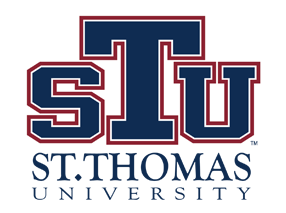
President David A. Armstrong, J.D. has a list of accomplishments in his first two years at St. Thomas University (STU) of which he can certainly be proud. But rather than reflecting on those successes, Armstrong marked the occasion of his second anniversary by instead focusing on STU’s bright future.
Since arriving in August 2018, Armstrong has revitalized a campus that was struggling financially. Among his achievements:
- For the first time in years, STU’s financial health is sound. In his first year, Armstrong turned a deficit of $4.6 million in net assets without donor restrictions into a surplus of $74,000. That was the first time since 2014 that STU had an operating surplus. FY20 preliminary operating results are even more positive. STU anticipates ending FY20 with a surplus in excess of $4 million prior to including net assets released from restriction for the College of Business construction project. Strong enrollment numbers, which exceeded the budget both at the undergraduate level and Law School, and prudent fiscal management of expenses, were key drivers leading to the positive fiscal results.
- Undergraduate enrollment, which is expected to surpass 1,400 students for the first time in school history when classes start Aug. 24, is up more than 44 percent over the past two years. Nationally, many small, faith-based private colleges are closing or struggling to survive, and others are laying off faculty and staff and eliminating programs.
- STU’s Law School has also achieved record enrollment growth, up over 36 percent since Armstrong took the helm. That bucks a trend of declining law school enrollment nationally; the American Bar Association reports that the number of students attending law school decreased 29 percent from 2010-2015, and 41 percent of law schools nationally experienced declines in first-year enrollment in 2019.
- In Armstrong’s first full year, the University raised more than $10.7 million, a one-year record for the university and an increase of 67.7 percent over the previous year.
- The university has renovated existing facilities, is opening a new facility for the Gus Machado College of Business this month, and is planning several new facilities. Murphy Family Hall (formerly Donnellon Hall) and Sullivan Hall, existing buildings that had not been used as residence halls for several years, were updated and reopened for their original use. The campus library has also received an extensive renovation. University trustees have approved future construction of a new residence hall, including a new dining hall and a student union. STU is also beginning construction on a new weight room and is seeking funding for fields and additional athletic facilities.
- A six-month strategic planning process culminated in a new five-year plan, titled Limitless, as well as new Vision and Mission statements. The plan is built on the pillars of Devotion, Opportunities, and Results.
- In collaboration with University faculty, a new Faculty Handbook has been developed that emphasizes excellence in the classroom, while at the same time making STU more economically sustainable long-term.
- The University has made significant investments in marketing, which has raised brand awareness across South Florida.
“The credit for the successes we’ve achieved goes to our trustees, faculty and staff,” Armstrong said. “Any success our institution has had these last two years is because of their dedication to the mission and implementation of our vision.”
But Armstrong has no intention of resting on his laurels. “There is still a lot of work to be done,” he said. “First and foremost, we have to execute on our strategic plan. During the six-month strategic planning process, we sent surveys to more than 15,000 stakeholders – including alumni, students, faculty and staff – and our 30-member steering committee did an excellent job of capturing their feedback and developing the plan. I am confident that we have the right plan to guide our future. Now, we have to execute. To help facilitate that execution, we’ve developed a template that details the action items associated with the plan. My Cabinet is charged with continually reviewing, updating, and reporting on those action items to ensure we are making progress toward our goals.”
For STU to achieve its goals, building upon last year’s record enrollment and record fundraising success will be critical. “Tuition revenue and fundraising revenue are the lifeblood of every small college and university in America,” Armstrong said. “We have some momentum right now with enrollment and fundraising, and we have to capitalize on that momentum. We are expecting another record year in enrollment when classes start August 24, which is exciting.”
“The key to fundraising is having a mission that resonates with donors, and effectively communicating that mission,” Armstrong said. “Last year, U.S. News & World Report ranked St. Thomas University #1 in the South Region for Social Mobility. That means we do a better job than any other institution in the region of taking students from economically disadvantaged situations, graduating them, and helping them land a well-paying first job. We are advancing human flourishing. That message resonates with a lot of donors.”
While the pandemic has had significant disruptions on higher education, Armstrong saw the crisis as an opportunity to better serve students. “We’ve implemented Bobcat Go!,” he said, “which provides flexibility and choice that students and families need right now. With Bobcat Go!, students can take their classes online, on campus – safely with masks, social distancing, and other precautions – or a combination of the two. They could take their classes on campus in the morning, and take their afternoon classes at home or in their residence hall. If the student lives abroad and can’t travel to the U.S. right now, they can take their classes in their home country until they are allowed to travel again. The pandemic forced this pivot, but there’s no reason why we shouldn’t be offering classes this way after the pandemic has subsided. I believe this is the future of higher education, and STU is leading the way.”

